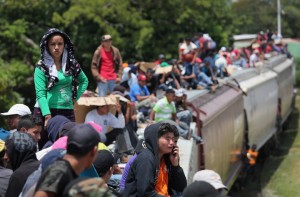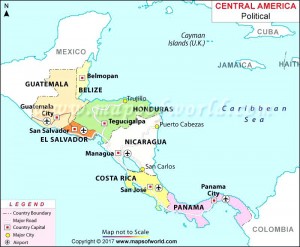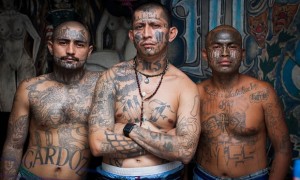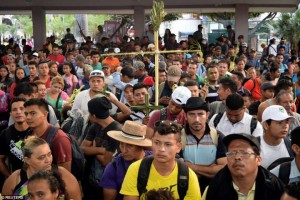One of the things which comes up frequently in the immigation controversy is asylum — immigrants seeking special protection from dangers and/or risks in their own country.
According to the U.S. Citizenship and Immigration Services (USCIS), asylum protection can be offered to people who have suffered persecution or fear they will suffer persection because of their race, religion, nationality, membership in a particular social group, or political opinion.
Notice the fairly narrow definition. Essentially it says that a particular person must be able to identify one of these specific reasons, and that they have been or are at danger of suffering persecution because of it. This is important, because we will be coming back this this definition.
Refugee and Special Situations
The USCIS notes special situations which could allow entrance into the United States of humanatarian concern, such as natual disasters. Generally speaking refugees and are not expected to stay in the United States, and are “sheltered” only until the situation which caused their flight from their country is resolved. As we shall see, this definition has been allowed to expand to cover several areas beyond its original intent.
The USCIS also designates “Temporary Protected Status” (TPS) for refugees from countries considered to be in turmoil. There are currently ten countries on this list, but for the purposes of this article, we will only be looking at some countries in Central America: El Salvador (9/9/19), and Honduras (1/5/20). The dates in parenthesis are the dates when this temporary status are schedule to end, but these dates can be changed.
Ostensibly, the TPS for the above countries was issued due to natural disasters: El Salvador: Earthquakes (2001), Nicaragua: Hurricane Mitch (1998), Honduras: Hurricane Mitch (1998). Notice these “temporary” protections are now twenty years old.
Immigrants from countries with TPS cannot be deported as long as the TPS is in effect. TPS holders reside all over the U.S. Most TPS holders from El Salvador live in the Washington, DC (32,359), Los Angeles (30,415) and New York (23,168) metropolitan areas. Honduran TPS holders live mostly in the New York (8,818), Miami (7,467) and Houston (6,060) metropolitan areas. (11)
Central America
The only thing stable about some of the countries that make up Central America is their instablity. Plagued by poverty, crime, and disease, this region suffers from continous instability.
Three countries form the “Northern Triangle” of Central America: Guatemala, El Salvador, and Honduras. They have a combined population of about thirty million people. The average per capita income in these three countries is $6793. Per capita income in the United States is $58030.
El Salvador
The smallest and most densely populated country in Central America (6.4 million), with a per capita income of $8900/year. It has the highest murder rate in the world, 60/100,000. (4) (7) (8)
From Wikipedia: “From the late 19th to the mid-20th century, El Salvador endured chronic political and economic instability characterized by coups, revolts, and a succession of authoritarian rulers… …devastating Salvadoran Civil War (1979–1992), which was fought between the military-led government and a coalition of left-wing guerrilla groups… …the country continues to struggle with high rates of poverty, inequality, and crime.”
According to CBS News some 60,000 to 100,000 members of the infamous MS-13 and Barrio 18 gangs terrorize the population throughout the country, causing many to flee for the United States (2)
In an interesting , if ironic footnote, the second largest gang in El Salvador, M-18 (also known as the 18th Street Gang), also actually originated in Los Angeles, and expanded south to El Salvador, sort of a north-south cultural exchange.
Sky News presents an interesting video of the realities of El Salvador today. It’s a little long (23 minutes), but interesting:
Temporary Protected Status (TPS) for some 195,000 Salvadorans currently in the United States ends in September 2019. President Trump has indicated he will not extend this date, making these TPS participants liable for deportation.
Guatemala
Guatemala has a population of 15.5 million and an annual per capita income of $8200. It has a murder rate of 26/100,000, and ranks as the 15th highest murder rate in the world (4) (7) (8)
Between 1954 and 1996, Guatemala suffered a series of coups and a civil war, destablizing the country. US involvement during this time period was not insignificant. Since then, Guatemalan politics have been rife with scandal. In 2016 a UN prosecutor described the government as a crime syndicate. Crime is high in Guatemala, largely as a result of continuing conflicts between the government and the people left over from the civil war. Guatemala is also a major drug trafficking route for drugs coming north from South America and headed to the United States. Guatemala is also known for human trafficking, including sex trafficking. Both MS-13 and the 18th Street Gang operate in Guatemala. There are an estimated 32,000 gang members in the country.
Since 2016 Guatemala has four times requested Temporary Protected Status (TPS) for Gualamalans illegally in the United States, based on volcanos and other natural disasters. TPS has not been approved.
Honduras
The third of our “Northern Triangle” countries of Central America is Honduras. Honduras has a population of about 9.1 million people, an annual per capita income of $5500, and a murder rate of 54/100,000 people, making it the 2nd highest murder rate in the world. (7)(8)
Like other countries in Central America, Honduras has suffered a variety of internal conflicts and governments, and interventions by the United States over the years. The term “Banana Republic” was first used to describe the country by author O. Henry in 1904.
In addition to dealing with hurricanes and other natural disasters, Honduras suffered a coup d’etat in 2009, that was condemned by both the Organization of American States and the United Nations, who called the new government illegal.
Temporary protected Status (TPS) granted to Hondurans after the 1998 Hurrican Mitch, is due to expire in January 2020. President Trump has indicated he will not renew this status, making 57,000 Hundurans currently in the United States liable to deportation.
The Failed States
At this point we get subjective. The fundamental definition of a failed state is “a state whose political or economic system has become so weak that the government is no longer in control” (Google Definitions).
The three countries in this article are technically not “failed”, but are considered “fragile” states by the non-profit Fund for Peace (12). The factors considered in evaluating countries are social, economic, and political. Each of these three countries fall within the “Warning” bracket of potentially failing states. The states are scored every year, and these countries exhibit a continually downward trend. In other words, it’s not getting better, it’s getting worse.
It should be noted that the United States provides foreign aid to these countries, mostly for education and agriculture, a total of about $50 million per year for all three combined, about the same provided to Bosnia ($49 million), less than to the Congo ($60 million), and far less than to Afghanistan ($126 million).
Which unfortunately brings us, once again back to the major problem faced in each of these countries: crime.
MS-13
“Mata, roba, viola, controla” (Kill, steal. rape, control)
That’s the MS-13 motto above. We’ve written about these bad boys before, but their impact on these countries, and the resultant flow of immigrants seeking asylum from them appears to be the single largest factor in the migration north.
“Mara Salvatrucha” is the name. “Mara” is slang for “gang”, and “Salvatruchas” are supposedly peasants trained to become guerilla fighters. The “13” denotes their affiliation with the “Surenos”, a group of gangs that pay tribute to the Mexican Mafia while in prison. Other variants of this explanation exist.
Ironically, this gang was home grown in the USA. The gang was formed by Salvadoran immigrants in the 1980’s in Los Angeles. The gang was created to protect Salvadorans from other gangs of Mexican and Afro-Americans. When gang members were caught committing crimes, they typically were deported back to El Salvador. This allowed them to recruit in Central America, and expand rapidly. Another similar gang, the Barrio 18, or 18th Street Gang, also formed in Los Angeles, and has a similar history. These two gangs account for the 60,000 to 100,000 gang members in El Salvador alone, along with another 32,000 in Guatemala, and thousands more in Honduras. There are an estimated 10,000 MS-13 members currently in the United States.
It needs to be noted that MS-13 is not a drug trafficking cartel. Though they have had some minor affiliations with Mexican Cartels, especially the Sinaloa Cartel, the gang’s participation in the drug trade is minor, perhaps due to a distrust between the primarily El Salvadoran members and the Mexicans. Murder, rape, extortion, prostitution and human trafficking are the calling cards of MS-13. In essense they are thugs, not nearly sophisticated enough to operate as a drug cartel.
Which brings us to the actual problem as it relates to the United States.
These gangs are essentally terrorists, and strongest in Central America. Their tactics, combined with ineffectual and/or corrupt governments in these countries have created a growing migration of people fleeing these countries and headed for the United States.
They head for the United States seeking asylum. Asylum from the criminal gangs terrorizing their countries. But they are also economic migrants, trying to escape poverty and failing government.
Coming back to our original definition of asylum, seeking protection from persecution: How does their claim match the policies of the United States? How liberal or how strict should the granting of asylum be? Remember, there are over thirty million people in these three countries. How many should the US allow, and for how long? A few years, until things possibly get better in their countries? Twenty years? Forever?
Most of these immigrants are low-skill, poorly educated people. Who supports them, and how will they fit in to the US economy? There are no easy answers to these questions. These problems will likely continue and increase in the coming years. It is the responsbility of the Congress of the United States to confront these problems and create suitable immigration laws, something they have failed to do for decades. Time is running out for decisions. Left alone, we will find ourselves with thousands or even millions of immigrants clamoring to get into the United States, and a government of our own who is failing both them and us.
(1) USCIS — Asylum
(2) CBS News: Firsthand Look El Salvador Gang Violence
(3)New York Times – Violence in Nicaragua…
(5)Honduras Violence — Philadelphia Inquirer
(6) Over 100 Politicians Murdered in Mexico
(7) United States Department of State
(8) List of Countries by Intentional Homicide Rate
(9) Gangs in Central America — Congressioal Research Service
(10) In Central America Gangs like MS-13 are Bad, but Corrupt Politicians May be Worse
(11) TPS Fact Sheet
(12) Fund for Peace



